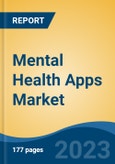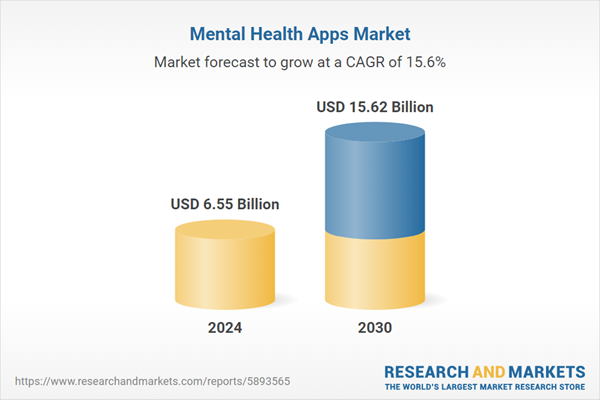Speak directly to the analyst to clarify any post sales queries you may have.
10% Free customizationThis report comes with 10% free customization, enabling you to add data that meets your specific business needs.
They typically include guided meditation sessions, mood tracking, cognitive behavioral therapy exercises, and even virtual support groups. What sets mental health apps apart is their accessibility - users can engage with these resources at any time, in the comfort and privacy of their own space. The appeal of mental health apps lies in their ability to provide personalized assistance. Through the collection of data, these apps can track users’ progress and adapt their recommendations accordingly. This data-driven approach allows for a more tailored and effective experience, ensuring that users receive content and strategies aligned with their specific needs.
Furthermore, mental health apps have played a significant role in normalizing conversations around mental well-being. By offering tools that promote self-awareness and emotional regulation, these apps empower users to take an active role in their mental health journey. They also serve as complements to traditional therapy, allowing users to reinforce their learning and practice between sessions. However, it's essential to approach mental health apps with a critical perspective.
Key Market Drivers
Rising Prevalence of Mental Health Disorders
The increasing prevalence of mental health disorders is a primary driver of growth in the global mental health apps market. As of recent global estimates, one in every eight individuals, approximately 970 million people worldwide, are affected by mental health disorders, with anxiety and depression being the most prevalent conditions. The COVID-19 pandemic in 2020 triggered a substantial surge in these cases, with anxiety disorders increasing by 26% and major depressive disorders rising by 28% within a single year. This sharp escalation underscores the urgent need for scalable mental health interventions, driving demand for digital mental health solutions and therapeutic applications.As mental health issues such as depression, anxiety, stress, and other psychological conditions continue to rise, the demand for accessible, affordable, and effective mental health solutions has surged. The digitalization of mental healthcare, supported by mobile applications, has emerged as a crucial response to this growing crisis. Below are the key ways in which the rising prevalence of mental health disorders is fueling the expansion of the mental health apps market. The growing incidence of mental health disorders has led to a significant increase in individuals actively seeking support. Traditional mental health services, such as in-person therapy and psychiatric consultations, often come with challenges like high costs, long waiting times, and social stigma. Mental health apps address these issues by offering on-demand, self-guided support, making mental healthcare more accessible to a broader population.
Key Market Challenges
Data Privacy and Security
One of the most significant challenges in the mental health apps market is ensuring the privacy and security of user data. These apps often collect sensitive information, including emotional states, stress levels, and personal stories. To foster trust, developers must implement robust encryption and data protection measures to safeguard users’ confidentiality.Striking a balance between personalization and data security is crucial. All user data, both in transit and at rest, should be encrypted to prevent unauthorized access. This includes information stored on servers and transmitted between the app and its servers. Apps should clearly explain the types of data collected, how it will be used, and who will have access to it. Users must provide informed consent before their data is collected.
Key Market Trends
Teletherapy Integration
Many mental health apps are integrating teletherapy options, allowing users to connect with licensed therapists via video or text. This trend bridges the gap between technology and professional care, offering users a comprehensive support system. For example, BetterHelp and Talkspace offer virtual therapy services as an integral part of their platforms.Key Market Players
- Mindscape Inc.
- Calm.com Inc.
- MoodMission Pty Ltd.
- Sanvello Health Inc.
- Headspace Inc.
- Flow Inc.
- Youper Inc.
- Silver Cloud Health Inc
- Happify Inc.
- Talkspace
Report Scope:
In this report, the Global Mental Health Apps Market has been segmented into the following categories, in addition to the industry trends which have also been detailed below:Mental Health Apps Market, By Platform Type:
- Android
- iOS
- Others
Mental Health Apps Market, By Application Type:
- Depression and Anxiety Management
- Meditation Management
- Stress Management
- Wellness management
- Others
Mental Health Apps Market, By Region:
- North America
- United States
- Canada
- Mexico
- Asia-Pacific
- China
- India
- South Korea
- Australia
- Japan
- Europe
- Germany
- France
- United Kingdom
- Spain
- Italy
- South America
- Brazil
- Argentina
- Colombia
- Middle East & Africa
- South Africa
- Saudi Arabia
- UAE
Competitive Landscape
Company Profiles: Detailed analysis of the major companies present in the Global Mental Health Apps Market.Available Customizations:
With the given market data, the publisher offers customizations according to a company's specific needs. The following customization options are available for the report.Company Information
- Detailed analysis and profiling of additional market players (up to five).
This product will be delivered within 1-3 business days.
Table of Contents
Companies Mentioned
- Mindscape Inc.
- Calm.com Inc.
- MoodMission Pty Ltd.
- Sanvello Health Inc.
- Headspace Inc.
- Flow Inc.
- Youper Inc.
- Silver Cloud Health Inc
- Happify Inc.
- Talkspace
Table Information
| Report Attribute | Details |
|---|---|
| No. of Pages | 181 |
| Published | March 2025 |
| Forecast Period | 2024 - 2030 |
| Estimated Market Value ( USD | $ 6.55 Billion |
| Forecasted Market Value ( USD | $ 15.62 Billion |
| Compound Annual Growth Rate | 15.5% |
| Regions Covered | Global |
| No. of Companies Mentioned | 10 |









